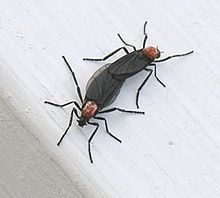
Back بليسيا نيركتيكا ARZ Plecia nearctica CEB مگس عشقباز Persian 러브버그 Korean Plecia nearctica Dutch Plecia nearctica NB Plecia nearctica Portuguese Plecia nearctica Swedish Plecia nearctica WAR
| Lovebug | |
|---|---|

| |
| Two lovebugs mating | |
| Scientific classification | |
| Domain: | Eukaryota |
| Kingdom: | Animalia |
| Phylum: | Arthropoda |
| Class: | Insecta |
| Order: | Diptera |
| Family: | Bibionidae |
| Genus: | Plecia |
| Species: | P. nearctica
|
| Binomial name | |
| Plecia nearctica | |
The lovebug (Plecia nearctica) is a species of march fly found in parts of Central America and the southeastern United States, especially along the Gulf Coast.[2] It is also known as the honeymoon fly or double-headed bug. During and after mating, matured pairs remain together, even in flight, for up to several days.[3]
The species was first described in 1940 by D. E. Hardy, though it had been observed in Louisiana as early as 1911.[4] At the time, Hardy reported the distribution of lovebugs to be widespread, but most commonly in Texas and Louisiana than other Gulf States.[2] By the end of the 20th century the species had spread to all areas bordering the Gulf of Mexico, the entirety of Florida, and had spread as far as Georgia and South Carolina. The species is also present in other countries, including Australia.[citation needed] L. A. Hetrick, writing in 1970, found the bug was also widespread in central and northern Florida and described its flights as reaching altitudes of 300 to 450 metres (980 to 1,480 ft) and extending several kilometers over the Gulf.[5]
Lovebugs' larvae feed on partially decayed vegetation in the landscape and, in this respect, are beneficial to humans. Adults primarily feed on nectar from various plants, particularly sweet clover, goldenrod, and Brazilian pepper.[2] The lovebug is considered a nuisance by many motorists, especially in Florida, due to its swarming behavior during the species' mating season.[6]
- ^ Hardy, D. Elmo (1940). "Studies in New World Plecia (Bibionidae: Diptera)". Journal of the Kansas Entomological Society. 13 (1). Kansas: Kansas (Central States) Entomological Society: 15–27. JSTOR 25081585.
- ^ a b c Denmark, Harold; Mead, Frank; Fasulo, Thomas (April 2010). "Lovebug, Plecia nearctica Hardy". Featured Creatures. University of Florida/IFAS. Retrieved 22 September 2010.
- ^ Leppla, Norman (September 2009). "Living with lovebugs". Electronic Data Information Source of UF/IFAS Extension. Institute of Food and Agricultural Sciences, University of Florida. Retrieved 23 September 2010.
- ^ Buschman, Lawrent L. (June 1976). "Invasion of Florida by the "Lovebug" Plecia Nearctica (Diptera: Bibionidae)" (PDF). Florida Entomologist. 59 (2). Florida Entomological Society: 191–194. doi:10.2307/3493971. JSTOR 3493971. Retrieved 8 February 2016.
- ^ Hetrick, L. (March 1970). "Biology of the 'love-bug', (Diptera: Bibionidae)" (PDF). Florida Entomologist. 53. Entomological Society of Florida: 23–26. doi:10.2307/3493110. JSTOR 3493110. Retrieved 23 September 2008.
- ^ "Love bugs 'worst in 20 years' say car washes who are ringing up the business". The News-Press. Retrieved 2023-08-04.